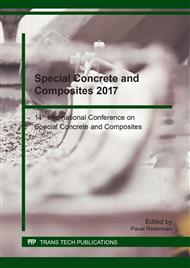[1]
X. Ping, J.J. Beaudoin, Modification of transition zone microstructure - silica fume coating of aggregate surfaces, Cem. Concr. Res. 22, 597–604 (1992).
DOI: 10.1016/0008-8846(92)90010-s
Google Scholar
[2]
M.D. Cohen, A. Goldman, and W.F. Chen, The role of silica fume in mortar: Transition zone versus bulk paste modification, Cem. Concr. Res. 24, 95– 98 (1994).
DOI: 10.1016/0008-8846(94)90089-2
Google Scholar
[3]
G. Appa Rao, B. K. Raghu Prasad, Influence of the roughness of aggregate surface on the interface bond strength, Cem. Concr. Res. 32, 253-257 (2002).
DOI: 10.1016/s0008-8846(01)00668-8
Google Scholar
[4]
G. Appa Rao, B. K. Raghu Prasad, Influence of type of aggregate and surface roughness on the interface fracture properties, Materials and Structures 37, 328-334 (2004).
DOI: 10.1617/13658
Google Scholar
[5]
L. Hong, X. Gu, and F. Lin, Influence of aggregate surface roughness on mechanical properties of interface and concrete, Construction and Building Materials 65, 338-349 (2014).
DOI: 10.1016/j.conbuildmat.2014.04.131
Google Scholar
[6]
S. Caliskan, B. L. Karihaloo, Effect of Surface Roughness, Type and Size of Model Aggregates on the Bond Strength of Aggregate/Mortar Interface, Interface Science 12, 361-374 (2004).
DOI: 10.1023/b:ints.0000042334.43266.62
Google Scholar
[7]
S.P. Shah, C. Ouyang, Toughening Mechanisms in Quasi-Brittle Materials, Journal of Engineering Materials and Technology 115, 300-307 (1993).
DOI: 10.1115/1.2904222
Google Scholar
[8]
D. Zampini, H. M. Jennings, and S. P. Shah, Characterization of the paste-aggregate interfacial transition zone surface roughness and its relationship to the fracture toughness of concrete, Journal of Materials Science, 30, 3149-3154 (1995).
DOI: 10.1007/bf01209230
Google Scholar
[9]
D.A. Lange, H. M. Jennings, and S. P. Shah, Relationship between Fracture Surface Roughness and Fracture Behavior of Cement Paste and Mortar, J. Am. Ceram. Soc. 76, 589-597 (1993).
DOI: 10.1111/j.1151-2916.1993.tb03646.x
Google Scholar
[10]
ČSN EN 196-1 Methods of testing cement. Determination of strength. Czech Standardization Institute. Prague (2005).
Google Scholar
[11]
ČSN EN 13454-2+A1 Binders, composite binders and factory made mixtures for floor screeds based on calcium sulfate. Test methods. Czech Standardization Institute. Prague (2008).
DOI: 10.3403/03011796u
Google Scholar
[12]
ISO 4287 Geometrical Product Specifications (GPS) - Surface texture: Profile method - Terms, definitions and surface texture parameters. International Organization for Standardization (1997).
DOI: 10.3403/30398213
Google Scholar
[13]
G. B. E. Jemec, G. L. Grove, Handbook of Non-Invasive Methods and the Skin, second ed., CRC/Taylor, Boca Raton (2006).
Google Scholar
[14]
R. Pernicova, M. Kostelecka, Influence of Mould Release Agent on Surface Properties of Concrete with Special Matrix, Advanced Materials Research 1025-1026, 637-640 (2014).
DOI: 10.4028/www.scientific.net/amr.1025-1026.637
Google Scholar


